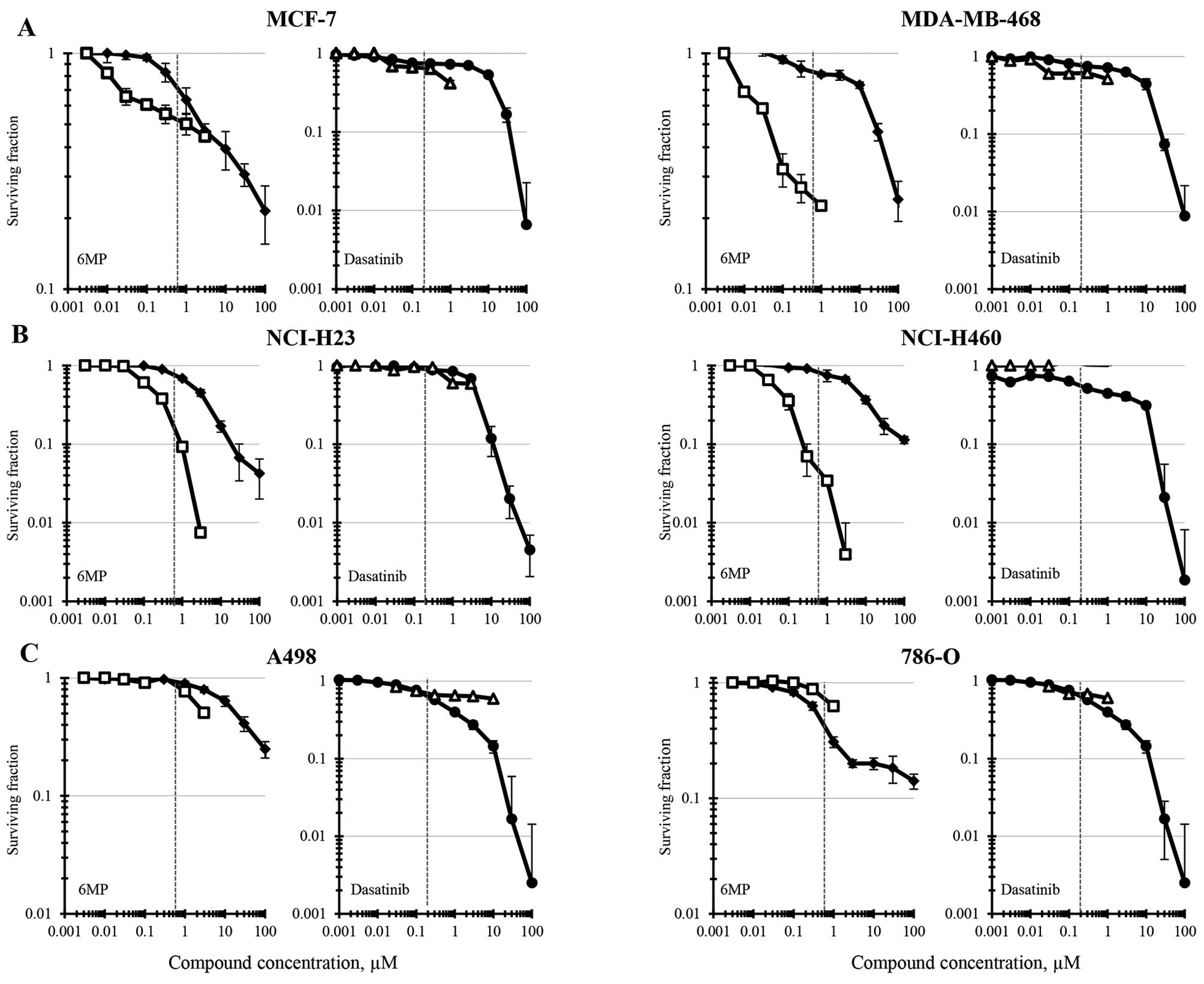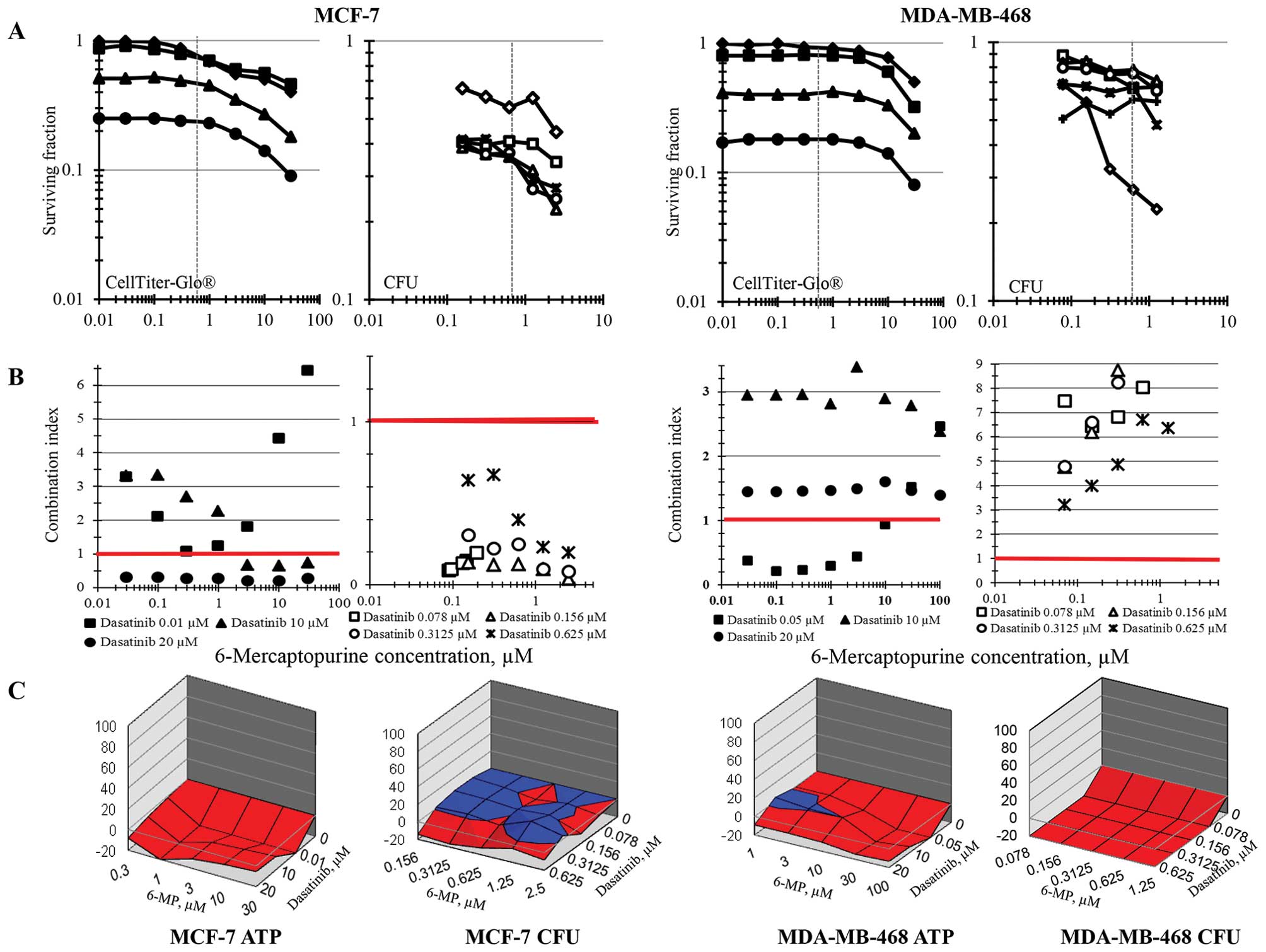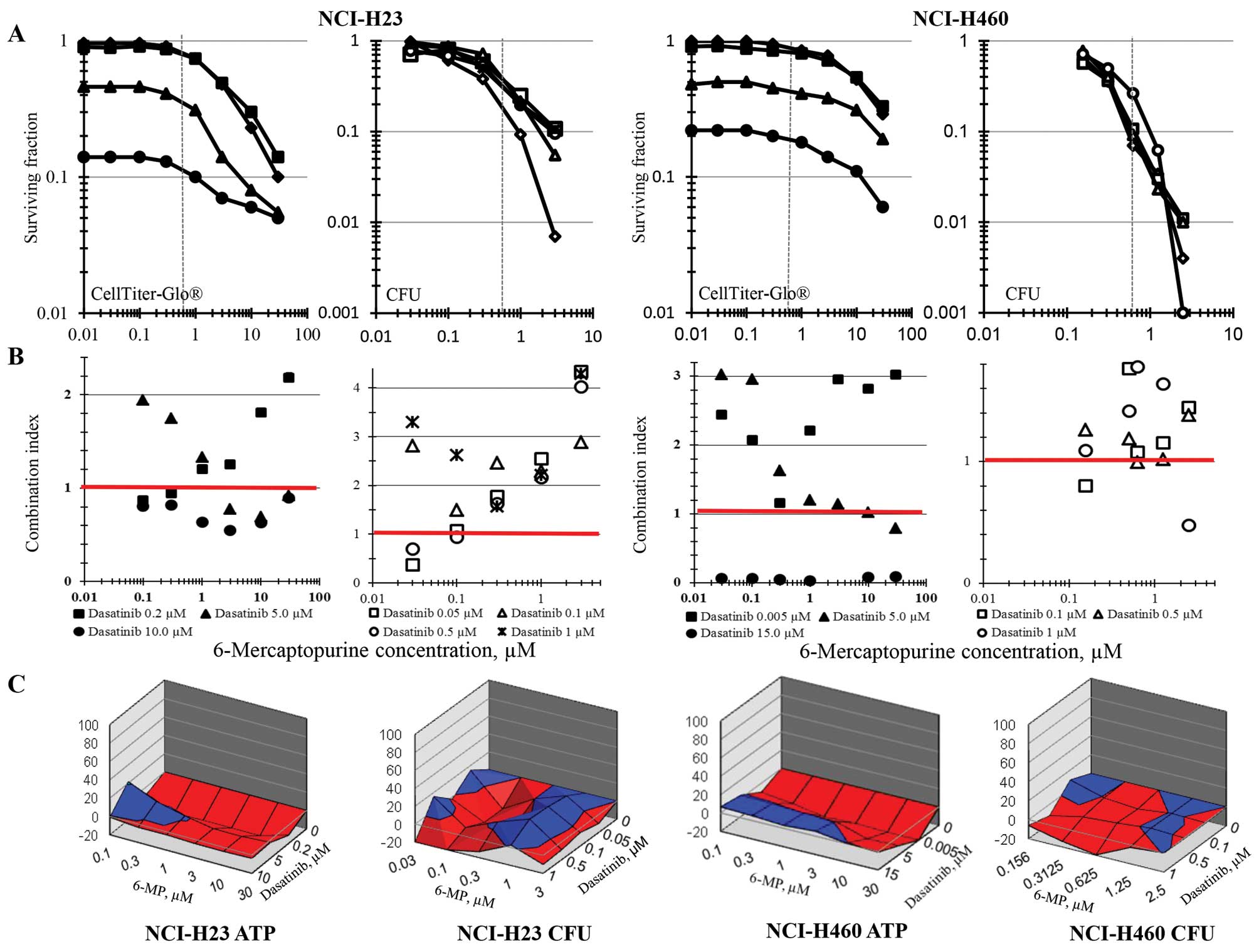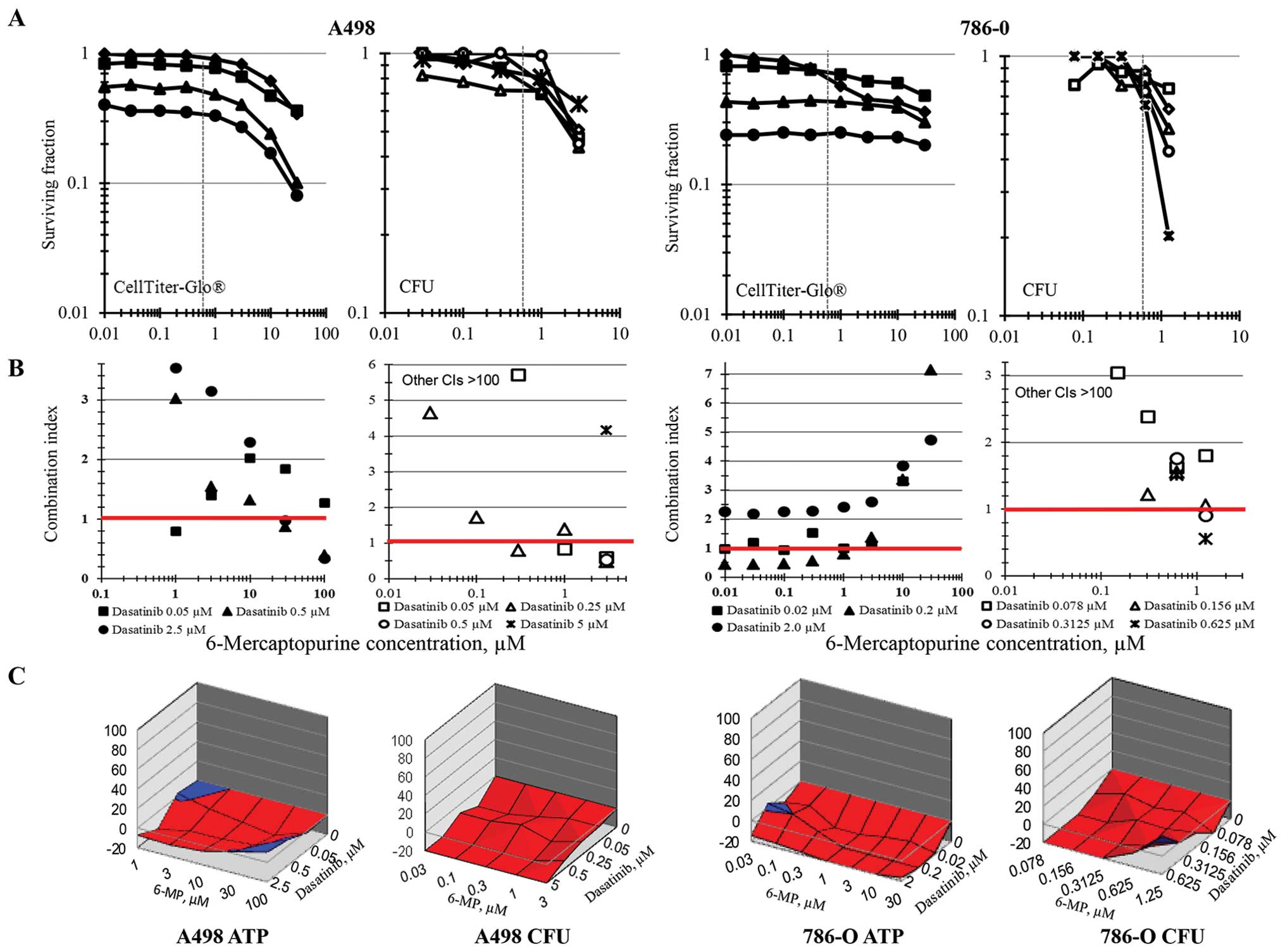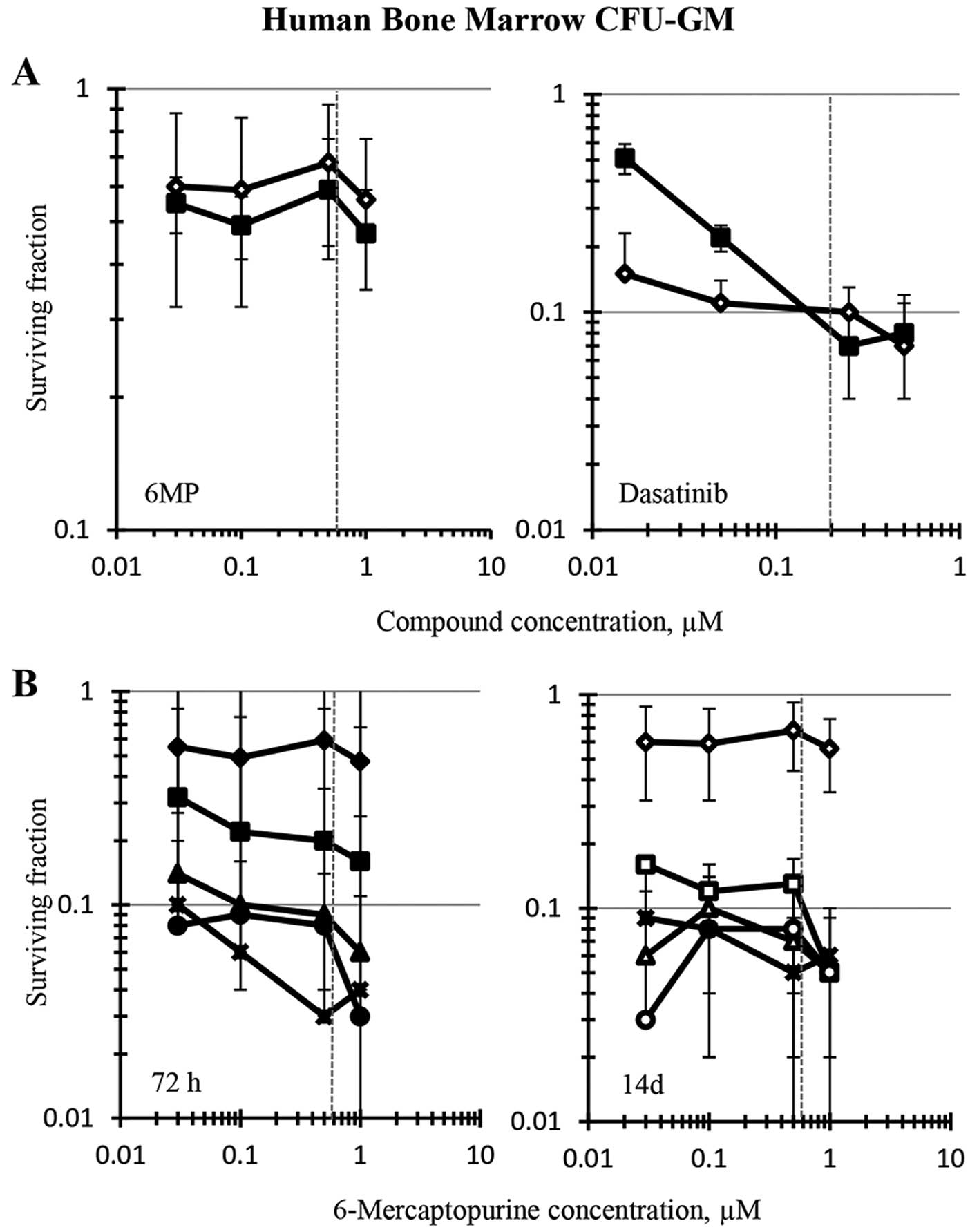|
1
|
Teicher BA, Herman TS, Holden SA and Eder
JP: Chemotherapeutic potentiation through interaction at the level
of DNA. Synergism and Antagonism in Chemotherapy. Chou TC and
Rideout DC: Academic Press; Orlando, FL: pp. 541–583. 1991
|
|
2.
|
Teicher BA: Human tumor xenografts and
mouse models of human tumors: re-discovering the models. Expert
Opin Drug Discov. 4:1–11. 2009. View Article : Google Scholar : PubMed/NCBI
|
|
3.
|
Sausville EA and Burger AM: Contributions
of human tumor xenografts to anticancer drug development. Cancer
Res. 66:3351–3354. 2006. View Article : Google Scholar : PubMed/NCBI
|
|
4.
|
Sausville EA, Elsayed Y, Monga M and Kim
G: Signal transduction directed cancer treatments. Annu Rev
Pharmacol Toxicol. 43:199–231. 2003. View Article : Google Scholar : PubMed/NCBI
|
|
5.
|
Gitler MS, Monks A and Sausville EA:
Preclinical models for defining efficacy of drug combinations:
mapping the road to the clinic. Mol Cancer Ther. 2:929–932.
2003.PubMed/NCBI
|
|
6.
|
Borisy AA, Elliott PJ, Hurst NW, Lee MS,
Lehar J, Price ER, Serbedzija G, Zimmermann GR, Foley MA, Stockwell
BR and Keith CT: Systematic discovery of multicomponent
therapeutics. Proc Natl Acad Sci USA. 100:7977–7982. 2003.
View Article : Google Scholar : PubMed/NCBI
|
|
7.
|
Tan M, Fang HB, Tian GL and Houghton PJ:
Experimental design and sample size determination for testing
synergism in drug combination studies based on uniform measures.
Stats Med. 22:2091–2100. 2003. View
Article : Google Scholar : PubMed/NCBI
|
|
8.
|
Grabovsky Y and Tallarida RJ:
Isobolographic analysis for combinations of a full and partial
agonist: curved isoboles. J Pharmacol Exp Ther. 310:981–986. 2004.
View Article : Google Scholar : PubMed/NCBI
|
|
9.
|
Zhao L, Wientjes MG and Au JLS: Evaluation
of combinations chemotherapy: integration of nonlinear regression,
curve shift, isobologram and combination index analyses. Clin
Cancer Res. 10:7994–8004. 2004. View Article : Google Scholar
|
|
10.
|
Zhao L, Au JLS and Wientjes MG: Comparison
of methods for evaluating drug-drug interaction. Front Biosci.
2:241–249. 2010. View
Article : Google Scholar : PubMed/NCBI
|
|
11.
|
Levasseur LM, Delon A, Greco WR, Faury P,
Bouquet S and Couet W: Development of a new quantitative approach
for the isobolographic assessment of the convulsant interaction
between perfloxacin and theophylline in rats. Pharm Res.
15:1069–1076. 1998. View Article : Google Scholar : PubMed/NCBI
|
|
12.
|
Greco WR, Faessel H and Levasseur L: The
search for cytotoxic synergy between anticancer agents: a case of
Dorothy and the ruby slippers? J Natl Cancer Inst. 88:699–700.
1996. View Article : Google Scholar : PubMed/NCBI
|
|
13.
|
Berenbaum MC: Re: W.R. Greco et
al., application of a new approach for the quantitation of drug
synergism to the combination of cis-diamminedichloroplatinum and
1-beta-D-arabinofuransylcytosine. Cancer Res 50: 5318–5327, 1990.
Cancer Res. 52:4558–4565. 1992.PubMed/NCBI
|
|
14.
|
Chou TC: Theoretical basis, experimental
design and computerized simulation of synergism and antagonism in
drug combination studies. Pharmacol Rev. 58:621–681. 2006.
View Article : Google Scholar : PubMed/NCBI
|
|
15.
|
Prichard MN, Aseltine KR and Shipman C Jr:
MacSynergy II. Version 1.0. User’s manual. University of Michigan;
Ann Arbor: pp. 1993
|
|
16.
|
Steel GG and Peckham MJ: Exploitable
mechanisms in combined radiotherapy chemotherapy: the concept of
additivity. Int J Radiat Oncol Biol Phys. 5:85–91. 1979. View Article : Google Scholar : PubMed/NCBI
|
|
17.
|
Prichard MN and Shipman C: A
three-dimensional model to analyze drug-drug interactions.
Antiviral Res. 1990:181–206. 1990. View Article : Google Scholar : PubMed/NCBI
|
|
18.
|
Pessina A, Albella B, Bayo M, et al:
Application of the CFU-GM assay to predict acute drug-induced
neutropenia: an international blind trial to validate a prediction
model for the maximum tolerated dose (MTD) of myelosuppressive
xenobiotics. Toxicol Sci. 75:355–367. 2003. View Article : Google Scholar
|
|
19.
|
Kurtzberg LS, Battle T, Rouleau C, Bagley
RG, Agata N, Yao M, Schmid SM, Roth S, Crawford J, Krumbholz R,
Ewesuedo R, Yo XJ, Wang F, LaVoie E and Teicher BA: Bone marrow and
tumor cell colony-forming units and human tumor xenograft efficacy
of noncamptothecin and camptothecin topoisomerase I inhibitors. Mol
Cancer Therap. 7:3212–3222. 2008. View Article : Google Scholar
|
|
20.
|
Masubuchi N: A predictive model of human
myelotoxicity using five camptothein derivatives and the in vitro
colony-forming unit granulocyte/macrophage assay. Clin Cancer Res.
10:6722–6731. 2004. View Article : Google Scholar : PubMed/NCBI
|
|
21.
|
Erickson-Miller C: Differential toxicity
of camptothecin, topotecan and 9-amino-camptothecin to human,
canine, and murine myeloid progenitors (CFUGM) in vitro. Cancer
Chemother Pharmacol. 39:467–472. 1997. View Article : Google Scholar
|
|
22.
|
Kumar S, Gutierrez M, Doroshow JH and
Murgo AJ: Drug development in oncology: classical cytotoxics and
molecularly targeted agents. Brit J Clin Pharmacol. 62:15–26. 2006.
View Article : Google Scholar : PubMed/NCBI
|
|
23.
|
Hitchings GH and Elion GB: The chemistry
and biochemistry of purine analogs. Ann NY Acad Sci. 60:195–199.
1954. View Article : Google Scholar : PubMed/NCBI
|
|
24.
|
Curto R, Voit EO, Sorribas A and Cascante
M: Validation and steady-state analysis of a power-law model of
purine metabolism in man. Biochem J. 324:761–775. 1997.PubMed/NCBI
|
|
25.
|
Salser JS, Hutchison DJ and Balis ME:
Studies on the mechanism of action of 6-mercaptopurine in cell-free
preparations. J Biol Chem. 235:429–432. 1960.PubMed/NCBI
|
|
26.
|
Kela U and Vijayvargiya R: Studies on the
mechanism of action of 6-mercaptopurine: interaction with copper
and xanthine oxidase. Biochem J. 193:799–803. 1981.PubMed/NCBI
|
|
27.
|
Salser JS and Balis ME: The mechanism of
action of 6-mercaptopurine. I. biochemical effects. Cancer Res.
25:46–52. 1965.
|
|
28.
|
Higuchi T, Nakamura T and Wakisaka G:
Metabolism of 6-mercaptopurine in human leukemic cells. Cancer Res.
36:3779–3783. 1976.PubMed/NCBI
|
|
29.
|
Aguilera DG and Tsimberidou AM: Dasatinib
in chronic myeloid leukemia: a review. Therap Clin Risk Man.
5:281–289. 2009.PubMed/NCBI
|
|
30.
|
Fanta S, Sonnenberg M, Skorta I, Duyster
J, Miething C, Aulitzky WE and van der Kuip H: Pharmacological
inhibition of c-Abl compromises genetic stability and DNA repair in
Bcr-Abl-negative cells. Oncogene. 27:4380–4384. 2008. View Article : Google Scholar : PubMed/NCBI
|
|
31.
|
Bantscheff M, Eberhard D, Abraham Y,
Bastuck S, Boesche M, Hobson S, Mathieson T, Perrin J, Raida M, Rau
C, Reader V, Sweetman G, Bauer A, Bouwmeester T, Hopf C, Kruse U,
Neubauer G, Ramsden N, Rick J, Kuster B and Drewes G: Quantitative
chemical proteomics reveals mechanisms of action of clinical ABL
kinase inhibitors. Nat Biotech. 25:1035–1044. 2007. View Article : Google Scholar : PubMed/NCBI
|
|
32.
|
Pan C, Olsen JV, Daub H and Mann M: Global
effects of kinase inhibitors on signaling networks revealed by
quantitative phosphoproteomics. Molec Cell Proteomics. 8:2796–2808.
2009. View Article : Google Scholar : PubMed/NCBI
|
|
33.
|
Secord AA, Teoh DK, Barry WT, Yu M,
Broadwater G, Havrilesky LJ, Lee PS, Berchuck A, Lancaster J and
Wenham RM: A phase I trial of dasatinib, a Src-family kinase
inhibitor, in combination with paclitaxel and carboplatin in
patients with advanced or recurrent ovarian cancer. Clin Cancer
Res. 18:5488–5498. 2012. View Article : Google Scholar : PubMed/NCBI
|
|
34.
|
Soule HD, Vazguez J, Long A, Albert S and
Brennan M: A human cell line from a pleural effusion derived from a
breast carcinoma. J Natl Cancer Inst. 51:1409–1416. 1973.PubMed/NCBI
|
|
35.
|
Brandes LJ and Hermonat MW: Receptor
status and subsequent sensitivity of subclones of MCF-7 human
breast cancer cells surviving exposure to diethylstilbestrol.
Cancer Res. 43:2831–2835. 1983.PubMed/NCBI
|
|
36.
|
Komarova EA, Zelnick CR, Chin D, Zeremski
M, Gleiberman AS, Bacus SS and Gudkov AV: Intracellular
localization of p53 tumor suppressor protein in gamma-irradiated
cells is cell cycle regulated and determined by the nucleus. Cancer
Res. 57:5217–5220. 1997.PubMed/NCBI
|
|
37.
|
Cailleau R, Olive M and Cruciger QV:
Long-term human breast carcinoma cell lines of metastatic origin:
preliminary characterization. In Vitro. 14:911–915. 1978.
View Article : Google Scholar : PubMed/NCBI
|
|
38.
|
Nigro JM, Baker SJ, Preisinger AC, Jessup
JM, Hostetter R, Cleary K, Bigner SH, Davidson N, Baylin S, Devilee
P, et al: Mutations in the p53 gene occur in diverse human tumor
types. Nature. 342:705–707. 1989. View Article : Google Scholar : PubMed/NCBI
|
|
39.
|
Gazdar AF, Carney DN, Russell EK, Sims HL,
Baylin SB, Bunn PA, Guccion JG and Minna JD: Establishment of
continuous, clonable cultures of small cell carcinoma of the lung
which have amine precursor uptake and decarboxylation cell
properties. Cancer Res. 40:3502–3507. 1980.PubMed/NCBI
|
|
40.
|
Mitsudomi T, Steinberg SM, Nau MM, Carbone
D, D’Amico D, Bodner S, Oie HK, Linnoila RI, Mulshine JL, Minna JD,
et al: p53 gene mutations in non-small cells lung cancer cell lines
and their correlation with the presence of ras mutations and
clinical features. Oncogene. 7:171–180. 1992.PubMed/NCBI
|
|
41.
|
Banks-Schlegel SP, Gazdar AF and Harris
CC: Intermediate filament and cross-linked envelope expression in
human lung tumor cell lines. Cancer Res. 45:1187–1197.
1985.PubMed/NCBI
|
|
42.
|
Takahashi T, Nau MM, Chiba I, et al: p53:
a frequent target for genetic abnormalities in lung cancer.
Science. 246:491–494. 1989. View Article : Google Scholar : PubMed/NCBI
|
|
43.
|
Giard DJ, Aaronson SA, Todaro GJ, Arnstein
P, Kersey JH, Dosik H and Parks WP: In vitro cultivation of human
tumors: establishment of cell lines derived from a series of solid
tumors. J Natl Cancer Inst. 51:1417–1423. 1973.PubMed/NCBI
|
|
44.
|
Fogh J, Wright WC and Loveless JD: Absence
of HeLa cell contamination in 169 cell lines derived from human
tumors. J Natl Cancer Inst. 58:209–214. 1977.PubMed/NCBI
|
|
45.
|
Williams RD, Elliott AY, Stein N and
Fraley EE: In vitro cultivation of human renal cell cancer. I.
Establishment of cells in culture. In Vitro. 12:623–627. 1976.
View Article : Google Scholar : PubMed/NCBI
|
|
46.
|
Williams RD, Elliott AY, Stein N and
Fraley EE: In vitro cultivation of human renal cell cancer. II.
Characterization of cell lines. In Vitro. 14:779–786. 1978.
View Article : Google Scholar : PubMed/NCBI
|
|
47.
|
Chou TC: Drug combination studies and
their synergy quantification using the Chou-Talalay method. Cancer
Res. 70:440–446. 2010. View Article : Google Scholar : PubMed/NCBI
|
|
48.
|
Balis FM, Holcenberg JS, Poplack DG, Ge J,
Sather HN, Murphy RF, Ames MM, Waskerwitz MJ, Tubergen DG, Zimm S,
Gilchist GS and Bleyer WA: Pharmacokinetics and pharmacodynamics of
oral methotrexate and mercaptopurine in children with lower risk
acute lymphoblastic leukemia: a joint children’s cancer group and
pediatric oncology branch study. Blood. 92:3569–3577.
1998.PubMed/NCBI
|
|
49.
|
Alpenc R, Blaney SM, Strauss LC, Balis FM,
Shusterman S, Ingle AM, Agrawal S, Sun J, Wright JJ and Adamson PC:
Pediatric phase I trial and pharmacokinetic study of dasatinib: a
report from the Children’s Oncology Group phase I Consortium. J
Clin Oncol. 29:839–844. 2011.PubMed/NCBI
|
|
50.
|
Elion GB: The purine path to chemotherapy.
Science. 244:41–47. 1989. View Article : Google Scholar : PubMed/NCBI
|
|
51.
|
Karran P and Attard N: Thiopurine in
current medical practice: molecular mechanisms and contributions to
therapy-related cancer. Nature Rev Cancer. 8:24–36. 2008.
View Article : Google Scholar : PubMed/NCBI
|
|
52.
|
Mardin BR, Lange C, Baxter JE, Hardy T,
Scholz SR, Fry AM and Schiebel E: Components of the hippo pathway
cooperate with nek2 kinase to regulate centrosome disjunction. Nat
Cell Biol. 12:1166–1178. 2010. View Article : Google Scholar : PubMed/NCBI
|
|
53.
|
Rosenthal AS, Tanega C, Shen M, Mott BT,
Bougie JM, Nguyen DT, Misteli T, Auld DS, Maloney DJ and Thomas CJ:
Potent and selective small molecular inhibitors of specific
isoforms of cdc2-like kinases (Clk) and dual specificity
tyrosine-phosphorylation-regulated kinases (Dyrk). Bioorg Med Chem
Lett. 21:3152–3158. 2011. View Article : Google Scholar : PubMed/NCBI
|
|
54.
|
Sartorelli AC: Some approaches to the
therapeutic exploitation of metabolic sites of vulnerability of
neoplastic cells. Cancer Res. 29:2292–2299. 1969.PubMed/NCBI
|
|
55.
|
Sosman JA, Puzanov I and Atkins MB:
Opportunities and obstacles to combination targeted therapy in
renal cell cancer. Clin Cancer Res. 13:764s–769s. 2007. View Article : Google Scholar : PubMed/NCBI
|















